USPTO UpdateTrademark Public Advisory Committee (TPAC) Quarterly Meeting
Nehal Madhani | November 08, 2022
On November 4, 2022, the USPTO held the Trademark Public Advisory Committee (TPAC) Quarterly Meeting, reviewing policies, goals, performance, and budget, among other important topics. This article provides a summary of key highlights from the meeting. Check out our summary of the last TPAC meeting: Q3 2022 TPAC Quarterly Meeting.
Trademarks Management Report
David Gooder, Commissioner for Trademarks, delivered the trademarks management report, specifically focusing on trademark application filing levels. For FY 2022, new application filings are down 16.5% as compared to filings in FY 2021. However, the number of newly filed applications is still up 6% over 2020 which follows the normal growth curve over prior years, excluding the unprecedented surge in filings in FY 2021. Commissioner Gooder noted that since March 2022, there has been a slow decline in new filings throughout FY 2022 which is consistent with what global IP offices are also seeing with newly-filed applications.
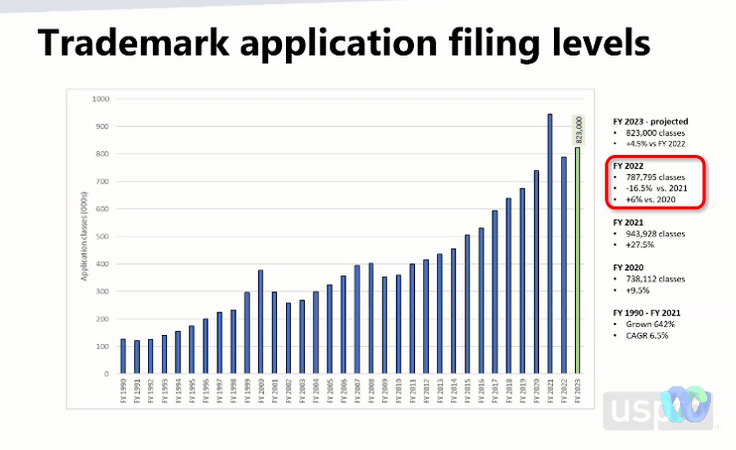
In terms of where new trademark filings are originating, thus far in FY 2022, about 64% of filings are coming from applicants domiciled in the US. China is back to its typical historic filing level at 16%. Applicants domiciled in Europe, Asia-Pacific, and the Americas are all filing at a slightly higher rate than in past years.
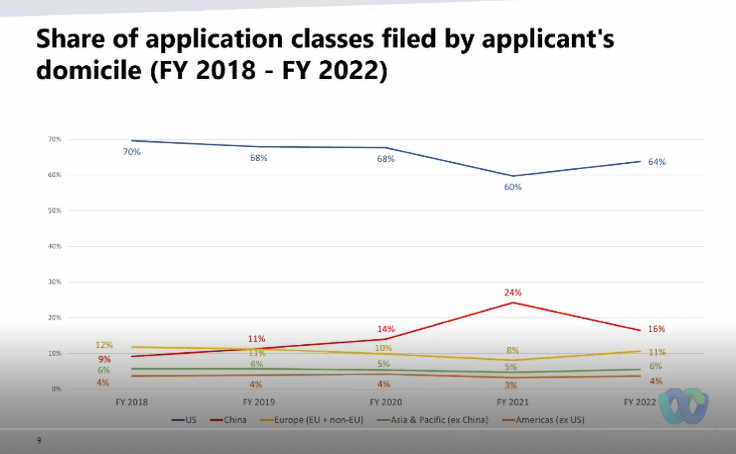
Next, Commissioner Gooder discussed trademark staffing. Trademark staffing now exceeds 1,100 employees (718 of which are examining attorneys). Telework has increased over the pandemic which has enabled the USPTO to hire more examining attorneys in different states, encouraging geographic diversity. Currently, there are examiners sitting in all but 8 states which helps to provide a different perspective when reviewing applications and helps to serve customers in different time zones.
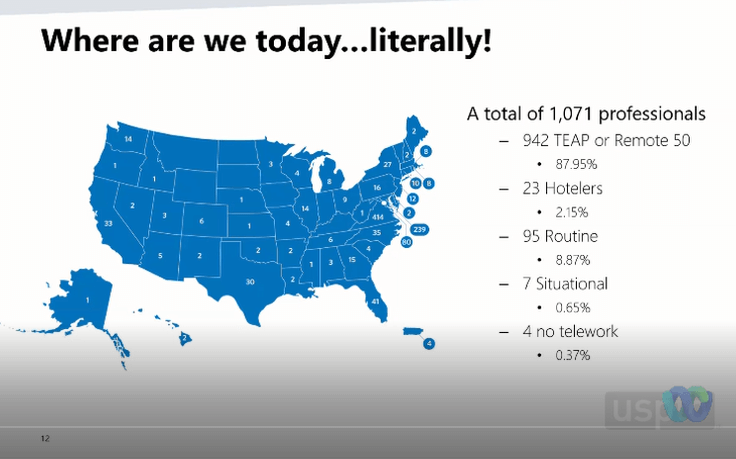
Financial Management Update
Sean Mildrew, Deputy Chief Financial Officer, provided a financial management update. The USPTO collected $8.2 million more than its appropriated levels which is deposited into the patent and trademark reserve fund. The USPTO is ending FY 2022 with $208.7 million in the reserve which is well-above the $120 million minimum. This is very good because the economic climate is uncertain and maintaining a reserve helps the USPTO maintain its operations and fulfill its mission.
Trademark Examination Policy Update
Amy Cotton, Deputy Commissioner for Trademark Examination Policy, delivered the trademark examination policy update. She began by discussing scams. She noted that the USPTO has recently learned about a scam letter sent to applicants, impersonating the USPTO, and offering to provide attorney services at exorbitant rates. She advised listeners to contact the Trademark Assistance Center to determine whether a notice you’ve received is legitimate or not.
Next, Deputy Commissioner Cotton discussed Trademark Modernization Act nonuse proceedings. She began by quickly outlining the various options for proceeding when you’ve discovered that a mark is no longer in use:
- Maintenance Filings – wait and see if the registrant files maintenance filings
- TTAB Petitions to Cancel – nonuse, abandonment, expungement, and fraud
- TMA Petitions to the Director – expungement and reexamination
She noted that the USPTO has a webpage that lists all of the TMA proceedings that have been filed and that the USPTO is working to improve the page and make a searchable database. She also set forth the current statistics for TMA filings:
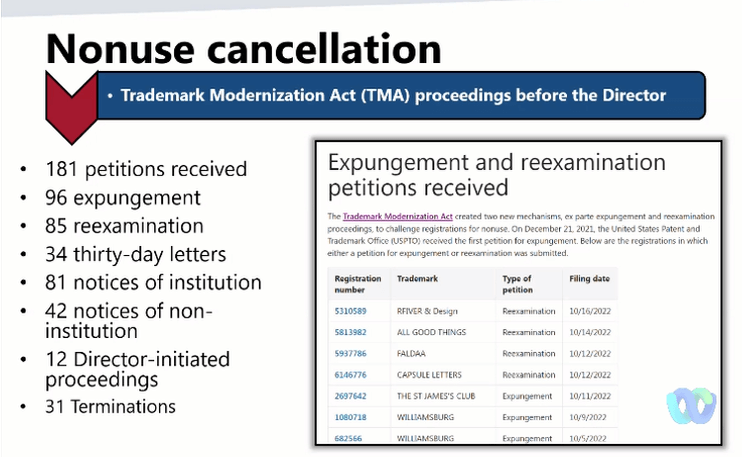
Next, Deputy Commissioner Cotton provided some tips for successfully initiating a TMA proceeding. Of note, she highlighted some specific advice for petitioners:
- If you are a lawyer and want to petition, use your law firm as the petitioner and use the law firm’s address as the domicile address so that you do not need to provide your personal domicile address.
- If you provide one bad specimen, the USPTO can only institute action on that one good, but if you provide additional evidence and the USPTO can infer nonuse from other pieces of evidence then the USPTO can institute action on all of the goods and services.
- If you provide evidence that the specimen came from a “specimen farm” (an e-commerce website where there are disparte goods, descriptions that don’t match products, etc.) provide this evidence to the USPTO.
- If you have evidence that the attorney on the registration has been sanctioned, be sure to provide that evidence.
- Don’t just provide the investigator’s report (which is testimonial); be sure to provide the documentary evidence as well.
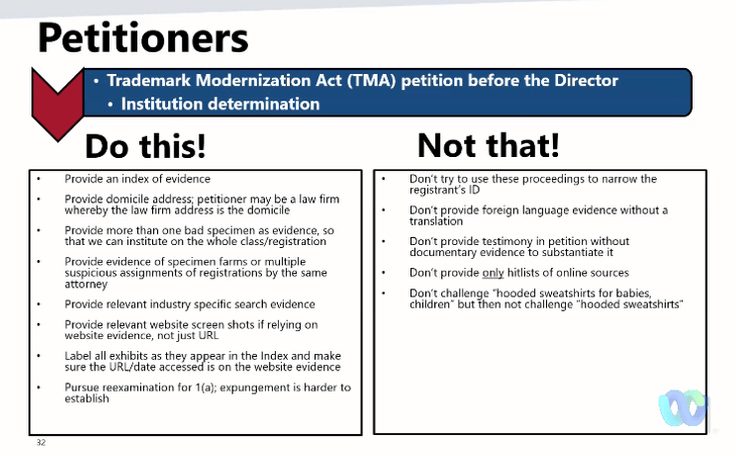
She also provided some tips for registrants, but noted that she doesn’t have too much advice as of yet because most registrants are defaulting and failing to provide a response in the prescribed time period.
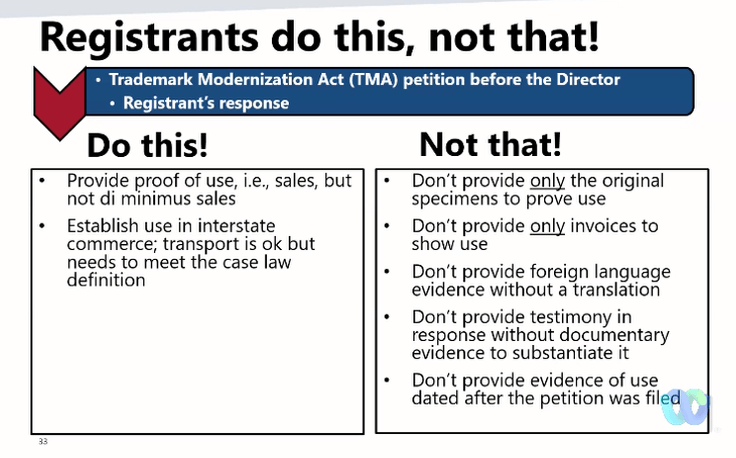
Finally, Deputy Commissioner Cotton provided an update on the administrative sanctions program. One of the sanctions available is to refer practitioners to the Office of Enrollment and Discipline (OED). The USPTO is seeing a rise in violations of the US verified account agreement whereby US attorneys are sponsoring foreign agents. Attorneys who violate the account agreement can be suspended from practice before the USPTO and referred to the OED. Also, the applications that were filed by foreign agents are being removed.
Professional Responsibility and Practice Before the USPTO
Will Covey, Deputy General Counsel and Director for the OED delivered an update on professional responsibility. He began by saying that the local counsel rule has been keeping the OED very busy. This rule requires that foreign-domiciled parties before the USPTO be represented by US attorneys.
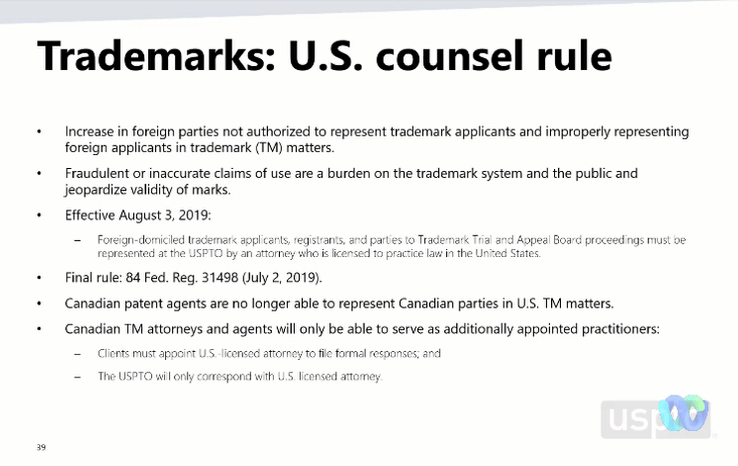
Many US attorneys who are not trademark practitioners are receiving solicitations from foreign parties asking to borrow or rent their US attorney license for a fee in order to submit filings before the USPTO. This is not permitted and attorneys are responsible for what is being filed with the USPTO under their names.
The USPTO learned of a solicitation sent to US attorneys (in Chinese) seeking attorneys who have credentials before the USPTO but do not have Chinese-sounding surnames. Director Covey ensured listeners that despite these solicitations, the USPTO is not targeting individuals with Chinese surnames.
Trademark Operations Update
Deputy Commissioner for Trademark Operations, Dan Vavonese delivered the trademark operations update. While the number of trademark applications in FY 2022 is down compared to FY 2021, there were still over 780k classes foiled. The First Action Pendency rose over FY 2022 to 8.3 months, whereas the goal is 7.5 months. Disposal Pendency ended at 13.8 months whereas the goal is 13.5 months. There has been a continuous rise in new applications/classes since mid-2020, but the good news is that inventory is leveling off and slowly going down. There is still a huge number of classes to get through and the oldest inventory is causing the pendency rate to be so high. Deputy Commissioner Vavonese also acknowledged that the USPTO is having challenges with post registration filing pendency which is over 100 days.
To help better manage the pendency rates, the USPTO is diligently working to hire more examiners. In FY 2022, 93 examining attorneys were hired and there are two new classes of examining attorneys to be hired in FY 2023. The Trademark Academy training program for new examiners has been very successful and has helped to improve consistency. Additionally, the examining attorneys are transitioning to a new examination system with improved technology. All examiners will be fully transitioned on December 1.
Deputy Commissioner Vavonese then issued a reminder about the new flexible office action response times under the Trademark Modernization Act that will go into effect on December 3. The USPTO will allow 3 months to respond to office actions and applicants may request a 3-month extension of time to respond. The 3-month flexible response time does not apply to applications filed under §66(a).